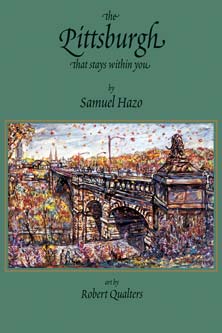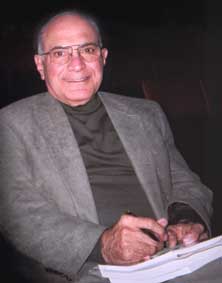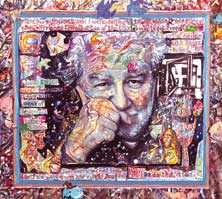
|
Want to find out where to buy?
Click BUYING button above. |
||

|
|
|||
|
ISBN 0-9744715-0-X,
|
|||
|
Samuel Hazo’s memoir of Pittsburgh began as an essay for Carnegie Magazine in the mid 1980s. Expanded into a book first published in 1986 and accompanied by the artwork of Robert Qualters, it took on a life of its own, finding readers from all walks of life. Now as a fourth edition, enlarged by the author and still with artwork by Qualters (much of which did not appear in previous editions), the book continues to touch us. As one reader put it in a succinct phone call to the author, “I just finished reading your book, and what you did was write the story of my life. Quote from the author: A city dweller named Aristotle remarked that a story should have a beginning, middle and an end. My memoir of Pittsburgh lacks a beginning and an end, but it assuredly has a middle. Commencing, as Aristotle would have approved, in the midst of things, it manages to stay right there. Since its unity is the unity of a single point of view entwined with anecdotes gathered haphazardly by the simple principle of addition, . . . it is what it is—a memoir that attempts to suggest that Pittsburgh did not arrive at its present status like Venus on the half shell, but that its present grew out of its past. That past exists in our collective memory if it exists at all. One of Aristotle’s successors noted in passing that the past is all we have. He was only half right. We have the present that the past made possible. This memoir is one man’s view of that possibility. 1992 Watching Lemieux on the ice makes one realize that there is Lemieux at one level and then there is everybody else. He seems to have the gift of seeing the game simultaneously at ice level and also from somewhere above the action. His reputation among Canadians was brought home to me once when I was saying goodbye to the distinguished Quebecois poet Gaston Miron at the Greater Pittsburgh International Airport. After he boarded his plane, I stood at the gate beside a man I did not know. We exchanged a word or two. He told me he was a Canadian who lived in Pittsburgh and added, “You have brought our best to the city.” I thought he was talking of Miron. I agreed, saying that Miron was probably the finest poet in the French speaking world at the moment. The man was puzzled. He waited a moment and said, “I was speaking of Mario Lemieux.” 1998 Ask me where I was born, and I will say the place exists no more except within me, literally inside of me. Where else is history but there in each of us? Tens of thousands of Pittsburgh's (each dawn reveals a similarly different city) have come into existence since I arrived on the scene. And many thousands will follow. No city (or no country, for that matter) stays the same. Granted, a city may remain within certain geographical boundaries, but within those boundaries there is continual destruction, construction and reconstruction. Some of the destruction may be due to entropy, but most will be the result of the desire within us to get rid of the no longer functional or beautiful or serviceable and replace it with something else - hopefully but certainly not always something better. 2003 The visions of writers and artists are crucial to the life of any city, and woe unto the city that derides or banishes or otherwise stultifies them. If intellectual conformity is the dominant 'ism' of our time, it is the arts that stand for intellectual and spiritual individuality and independence. They exist to remind us of who we really are. They mirror us to ourselves whether we like what we see or not, and they tell us what we truly know but which we sometimes forget. |
||
|
||||||||
|
|
||||||||

